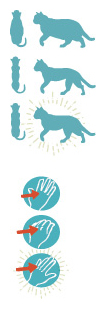Weight Loss Tips for Cats
Why weight loss foods rarely work
Domesticated cats are remarkably similar to their wild ancestors, and as obligate carnivores, cats do best on a prey model, meat-based diet with little or no carbohydrates. Unlike domesticated dogs, they never developed the ability to produce enzymes needed for efficient carbohydrate utilization. A cat’s system will utilize protein and fat for energy before carbohydrates, and is more likely to store dietary carbs as body fat.
Because of this, conventional weight loss formulas rarely work. They generally contain less protein and fat and are full of hidden carbohydrates. This encourages more fat storage, constant hunger and even some loss of muscle mass as cats start to use their own muscle tissue as a source of energy. Cats will get lean and muscular, however, if their food is high in proteins and fats, very low in carbohydrates, high in moisture, less processed – and sensibly portion controlled.
Guidelines for Slimming Down a Cat
Reduce or eliminate dry kibble
The biggest driver of feline obesity is dry food. All kibble needs significant carb content to hold the nugget together, and that can quickly raise blood sugar levels, triggering hunger and cravings when the levels come down again. Another drawback is the lack of moisture. Fresh prey contains 60–70% moisture, which gives a feeling of fullness and satiety that cats never get with dry food alone.
End free feeding
Leaving food out all day encourages constant nibbling and doesn’t allow the digestive system to go into a resting state. It’s better to feed two distinct meals a day with an optional late-night snack to tide your cat over until morning.
Remove and wash the bowl after 20 minutes whether your cat eats the food or not, otherwise, the smell of uneaten food will keep their body in digestion mode all day.
Don’t be afraid of fats
Unlike carbs or protein, fat doesn’t stimulate the release of insulin, the hormone that causes blood sugar to drop quickly. Fat helps curb hunger for hours and spares valuable protein for muscles and tissue repair instead of energy needs.
Although it may seem logical to choose a weight-loss food based on low-fat content, many low-fat foods replace the fat with hidden carbohydrates not listed on the guaranteed analysis. Instead, the food with the highest percentage of protein plus fat combined has the least carbs and is usually the best choice. While fat has more calories per gram, you can compensate for this by feeding a bit less.
Add less processed, moist foods
This is the true weight loss key. Frozen raw food for cats is the nutritional gold standard, but re-hydrated freeze-dried raw and high meat, human-grade canned food can work wonders as well. They are most like the natural diet cats evolved on, with high protein, moderate fat, and essential vitamins and minerals in the
right proportions.
Eliminating dry food can result in weight melting off each week. Even replacing one meal a day with moist food can make a difference, or you can add some to each meal. Be sure to subtract an equal amount of the old food to offset the calories. Some cats aren’t fond of change, and introducing new foods can be a lengthy and arduous process taking a month or more. Ask an All The Best pet care specialist for tips on transitioning.
Practice portion control
Without rigorous and consistent portion control, even a totally moist diet won’t slim your cat down. It’s vital to establish what your cat needs to maintain the weight they are right now, and then deduct 10% for a slow and steady weight loss that is just below the hunger threshold. To do this, make sure to measure servings at every meal.
Remember that every cat is unique – your cat’s feeding level may be different from what is recommended on the bag or can.
If you have a baby scale, you can keep track of your cat’s weight. If not, check your cat’s ribs weekly to see the progress (see reverse), and raise the feeding level a bit when they’ve reached an ideal size. By slimming down with the right diet, your kitty will soon have their mojo back!
How to check your cat’s weight
If your cat has:
 …no waist when viewed from above and their stomach looks rounded from the side, they’re above their ideal weight.
…no waist when viewed from above and their stomach looks rounded from the side, they’re above their ideal weight.
…rib and hip bones that are highly visible, they’re underweight.
…a waist that’s visible when viewed from above, they’re at their ideal weight.
For fluffy cats, if their ribs feel:
…like the inside of your knuckles on your palm, they’re overweight.
…like your knuckles when you make a fist, they’re underweight.
…like your knuckles when your hand is flat, they’re just right.

